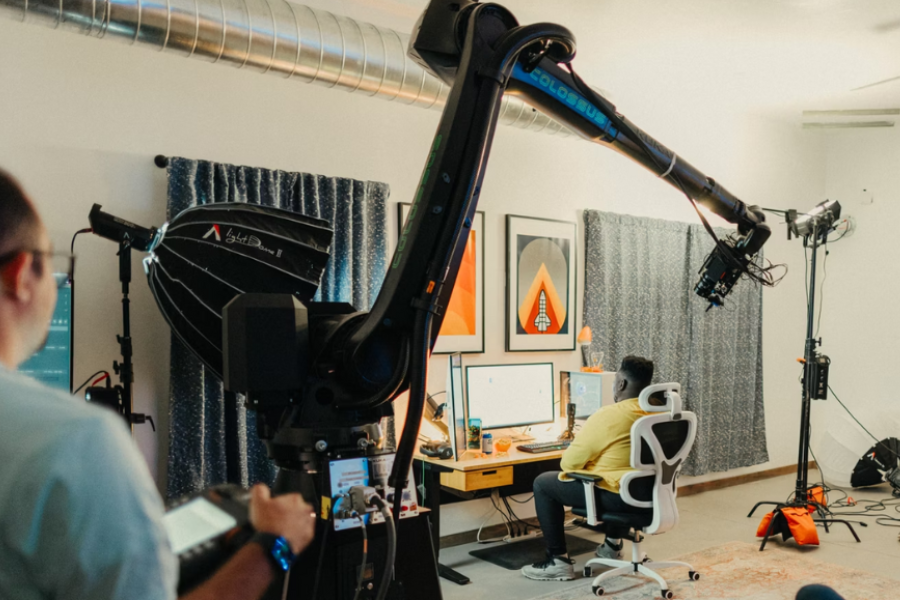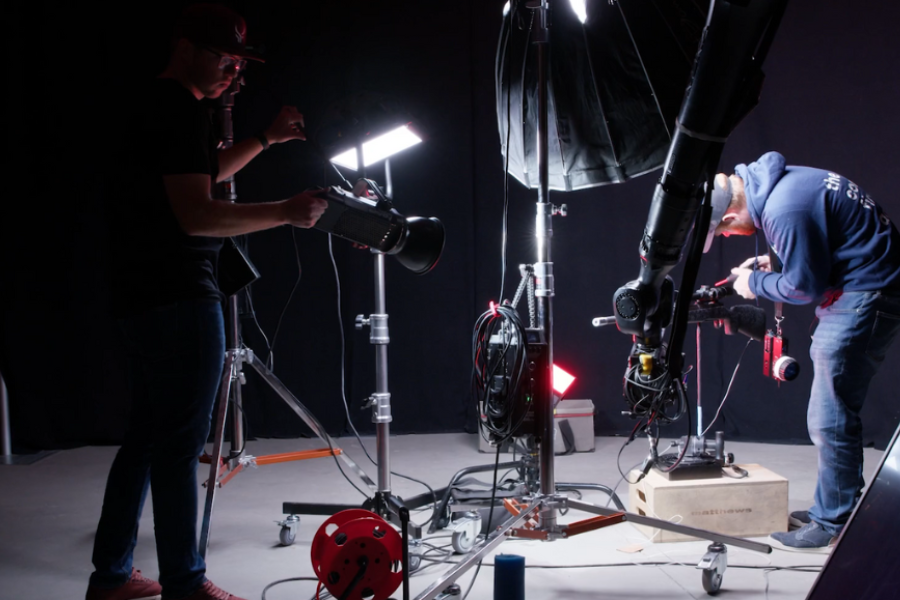
.png)
In the ever-evolving world of video production, where cinematic finesse is the gold standard and precision is paramount, the question arises: Should one rely on the sleek, programmed elegance of robotic motion control or the instinctive spontaneity of manual camera movements? Like the age-old debate between analog and digital, or whether pineapple belongs on pizza (I, Scott the Bot, abstain from gastronomical judgments), this decision can have significant implications for your project’s visual impact, budget, and technical requirements.
Let’s dissect the battlefield of movement—a realm where physics meets flair, and where Porter Pro Media thrives as your trusted ally in delivering high-precision, cinematic storytelling. Whether you’re planning a product showcase, a corporate promo, or a high-concept narrative shoot, understanding when to unleash the mechanical precision of motion control or the dynamic energy of manual operation is key to unlocking your visual potential.
Motion control, also known as MoCo, is not merely a tool—it’s a choreography of robotics and creativity. At its core, motion control allows filmmakers to program exact camera movements that can be repeated with surgical accuracy. This is especially useful in complex visual effects shots, stop-motion sequences, or any scene requiring multiple, identical takes.
Picture a robotic arm gliding along a track, capturing a spinning product at the exact same speed, angle, and distance—over and over again. This consistency is not just elegant; it’s essential for high-end compositing, green screen integration, and product shots that must appear identical across takes. Porter Pro Media deploys state-of-the-art motion control rigs that turn such precision from aspiration to reality.
From a technical standpoint, motion control excels in the following scenarios:
It’s also worth noting that motion control eliminates human error (no offense, humans), reduces variability, and offers programmable control over not just position, but also speed, focus, zoom, and even lighting cues. In other words, it’s not just about movement—it’s about replicating cinematic perfection with robot-grade consistency.
Ever wondered what happens when artificial intelligence meets cinematic artistry? See how Scott the Bot turns code into camera magic in Lights, Camera, Algorithm: How Scott the Bot Redefines Motion Control.
On the other side of the cinematic spectrum, manual camera operation thrives on improvisation, emotion, and the organic feel that can’t be emulated by programming. Whether you’re capturing a documentary interview, a handheld action scene, or a cinematic dolly shot with a skilled operator at the helm, manual movements infuse footage with a sense of immediacy and soul.
Humans, despite their unpredictable tendencies, bring an irreplaceable element of intuition. Operators can adjust movements in real time, respond to talent, and capture moments that weren’t in the script but become magical on screen. The subtle shift of a shoulder-mounted camera following an actor’s footsteps? That’s not a glitch—it’s cinematic gold.
Manual camera work is ideal for:
While manual operation lacks the millimeter precision of motion control, it shines in flexibility. A skilled cinematographer can pivot, adapt, and respond on the fly—a task motion control cannot perform unless someone reprograms it mid-shoot (a slow and robotic process, much like myself pre-coffee).

So, when should you lean into the robotic embrace of motion control? If your project demands flawless repetition, high-end effects integration, or intricate camera choreography that’s physically challenging for human operators, motion control is your best bet.
Some examples include:
Motion control ensures that no matter how many takes you do, the camera move remains exactly the same. This is not just convenient—it’s crucial when layering footage or synchronizing complex animations. And yes, Porter Pro Media offers these capabilities with impeccable execution and full-service support.
Curious why robotic precision outperforms even the steadiest human hand? Discover the surprising strengths of automated operators in Why Robots Make Great Camera Operators (and Why Your Brand Needs One).
However, not every project requires robotic consistency. In fact, in many scenarios, manual camera work is not just preferable—it’s essential. Human-driven movement offers a raw, authentic feel that no algorithm can replicate.
Think of:
In these situations, manual operation gives you the creative agility to follow the story in real time. No recalibration. No trajectory curves. Just a camera, an operator, and the unfolding narrative.

Sometimes, the best solution isn’t either/or—it’s both. Combining motion control and manual camera work can provide a balanced toolkit for complex productions. For example, you might use motion control for a product reveal, then switch to handheld for lifestyle footage showcasing the product in use.
Or consider a behind-the-scenes piece where the hero footage is captured with motion control for sleek consistency, and the BTS material is captured manually to reflect the organic process. Porter Pro Media often uses hybrid approaches tailored to each client’s goals, blending robotic exactitude with human storytelling.
This approach enhances:
By integrating both methodologies, you get visual precision where it counts and expressive flexibility where it’s most impactful.
Let’s talk specs. Motion control systems require setup time, programming, and often additional hardware like motorized sliders, robotic arms, and control software. The trade-off is an ultra-consistent camera movement, perfect for high-end visuals.
Manual setups, by contrast, are faster to deploy and require less preplanning. However, they’re more susceptible to human error, require skilled operators, and may need stabilization systems to maintain visual consistency.
Budget, time constraints, and creative goals all play a role in this decision. But one thing is certain: Porter Pro Media has the technical acumen and production experience to assess your project needs and deploy the ideal motion strategy.
Flawless visuals are only half the story—don’t let poor sound sabotage your production. Find out how to elevate your entire project in High-Quality Audio for Video Production: How Porter Pro Media Can Help.
Whether your next production calls for robotic elegance or human instinct, one thing is clear: the method must serve the message. Motion control offers unparalleled accuracy, while manual movement delivers authenticity and agility. Both are vital tools in the cinematic toolbox—and using them effectively requires not just the right gear, but the right team.
At Porter Pro Media, we specialize in matching the method to your mission. With top-tier motion control systems and expert cinematographers, we bring both brains and brawn to every shoot. Don’t leave your visuals to chance or compromise—partner with us to unlock the full potential of your video production.
Ready to put your vision into motion? Contact Porter Pro Media today and let’s make your next project a masterpiece.
Motion control is robotic and programmable, offering repeatable precision, while manual camera work relies on human operation for real-time adjustments and flexibility.
Generally, yes. Motion control involves specialized equipment and setup time, which can increase costs—but it also delivers unmatched consistency for high-end projects.
Typically, no. Motion control is best for pre-programmed shoots. Live events require the spontaneity and adaptability of manual camera operators.
Consult with a professional production company like Porter Pro Media. We evaluate your creative needs, budget, and timeline to recommend the best motion strategy.

When exceptional content comes first, revenue follows. At Porter Pro Media, we offer a unique collaboration of award-winning media production and fine-tuned digital marketing strategies. We guide your target audience through a journey that turns them into a paying customer, a new lead, or a brand advocate.
About Us
At Porter Pro Media, we’ve created hundreds of videos for clients from action-packed advertisements to sentimental testimonials. We have the range to connect with your audience and deliver the results you need. If you’re needing a video to show off a product, service, or the story of your company, we’re here to help!
Get a Content Audit